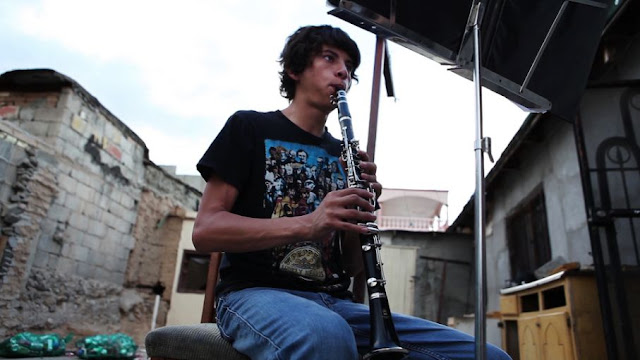Mexico: A Clarinet Instead of a Gun
This article originally published in Pulitzer Centre. Posted here by Farah Hazwani for educational purposes only.
 |
| Source: Pulitzer Centre |
By Susana Seijas
Esteban Ruiseco picks up his clarinet and starts practicing Arturo Márquez’s “Danzón No. 2.” He could’ve easily been picking up a gun.
Esteban fits the perfect profile for a Nini – he’s 15, comes from a broken home and has dropped out of school a couple of times. Nini is slang for “ni estudian, ni trabajan” – those who neither work nor study. Ninis are often easy prey for Mexico’s ruthless drug cartels. There are estimated to be some 10 million Ninis across Mexico, but the largest concentration is in Juárez, where Esteban is from.
“Before finding the orchestra, my life had no direction. I was stressed all the time. Watching the news on TV you’d see nothing but executed people. Why work if I was going to end up like that?” said Esteban of what it’s like to be young in Juárez, the epicenter of much of the drug-related violence plaguing Mexico.
Of the nearly 48,000 victims of violence since President Felipe Calderon declared war on Mexico’s drug cartels, more than 8,000 deaths were in Juarez, a city of 1.3 million across the border from El Paso, Texas. Carjacking and shootouts are common. Even worse, teenagers there have sometimes been targeted by cartels, gunned down at parties, killed quickly and indiscriminately. It is estimated that more than 1,000 young people under the age of 18 have been killed since the start of the government’s war on drugs.
Many teens like Esteban have witnessed violence firsthand. Once, on his way to the daily three-hour orchestra practice, a man with a gun hopped on the bus Esteban was riding and started mugging people. “The man took all I had on me, three pesos (less than 25 cents), and asked what I had in the case. I told him a clarinet; he turned away. Thank God he didn’t take my clarinet.”
Esteban, who now lives with his grandmother after his parents separated, said, “You can’t let fear rule your life. I’m very lucky, the orchestra has given me a purpose in life.”
He found the orchestra by chance. His sister had seen an ad for applications in the local paper and urged him to apply even though he’d never played a musical instrument.
“It’s been a drastic change. Instead of sleeping all the time and hanging out, or learning how to do or deal drugs, I go with my friends to play music,” said Esteban. “Now I don’t have to behave badly for people to pay attention to me.”
People are paying attention to the 230 youngsters who make up the Esperanza Azteca (Aztec Hope) Juárez Youth Orchestra, which premiered in July last year – nine months after starting from scratch.
The orchestra is the brainchild of Ricardo Salinas Pliego, the owner of TV Azteca, whose non-profit arm, Fundación Azteca, is promoting a national network of youth orchestras based on the Venezuelan "El Sistema" model, (where Gustavo Dudamel, now director of the Los Angeles Philharmonic, got his start). The program is currently being developed in 23 states across Mexico, involving 5,000 children. The program, in conjunction with state governments, uses music to connect young people to society and offer an alternative to Nini lifestyles.
Guillermo Quezada, the director of the orchestra, travels from the safety of El Paso to Juárez several times a week to conduct practice sessions. He says the work here is the best thing he’s ever done. “It’s a privilege, an honor to work with these kids,” said Quezada, who was born in Juárez. “I remember when we had one of the first recruiting sessions at one of the malls. Most kids had never seen an oboe or a clarinet, and in two years’ time from now they’ll be able to play any piece of music.”
“What’s amazed us is the unexpected response from parents – who come from all sectors of society,” said Jove García, the 28-year-old orchestra coordinator, himself a victim of several carjackings. “Parents tell us kids have improved the situation at home – whether it be better discipline or communication – or that music and the orchestra have become an enormous source of pride for the whole family, bringing them closer together.”
García recalls the early days of the orchestra when he had problems with Esteban’s attitude. “He wasn’t respectful. We don’t allow kids to have girlfriends or boyfriends here to prevent problems, and because of Esteban’s likeable personality, many girls wanted to hang out with him and another boy was jealous. It was pretty intense, but I had to interfere. Luckily all that’s in the past,” said García, who is seen as a father figure by many of the young orchestra members.
Since then, García says he’s not had a problem with Esteban. “His change was pretty quick. The first piece the whole orchestra played together was the point that everyone changed. They had to be team players,” he said.
Nowadays, when García hears Esteban play the opening to “Danzón” he knows he’s working hard. “His solo piece is very peaceful and I feel he’s on the right path,” he said.
Comments
Post a Comment